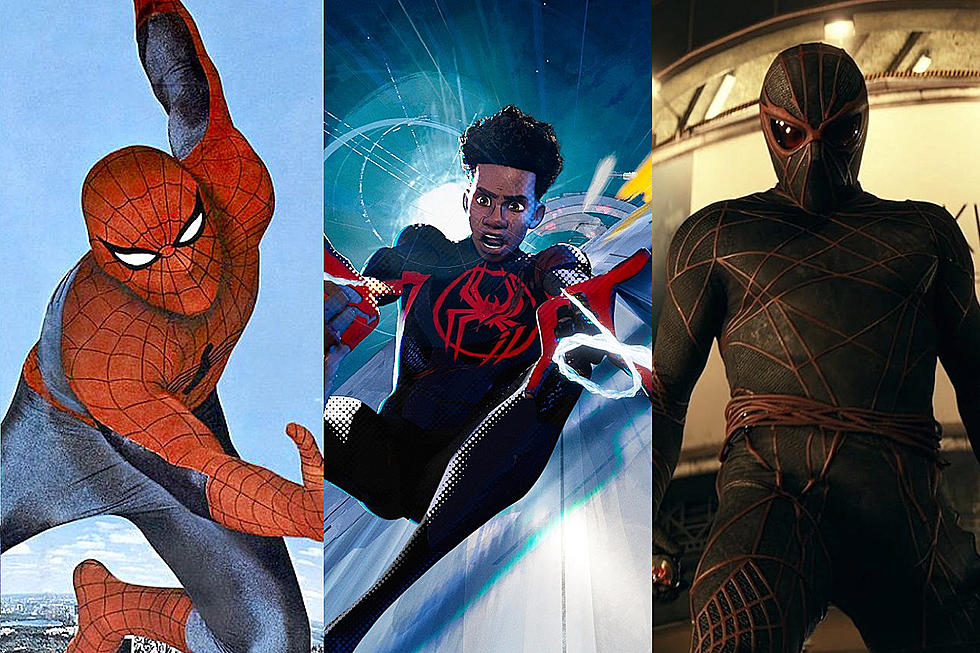
The 5 Worst Comics of 2010
Over the last couple weeks, the ComicsAlliance staff has shared our Top 10 favorite comics and graphic novels of 2010, the books that felt like Christmas morning, the ones that stuck in our hearts and our minds and made us proud to be comic book fans. But in every medium, a little rain must fall, and so we would be remiss if we weren't honest about the lowlights as well as the highlights -- the comics that best represented the biggest missteps and the most problematic trends in comics writing during the last 12 months. And so with no further ado, we offer you: The 5 Worst Comics of 2010.
5. VAGINAPOCALYPSE TIE -- Titans: Villains for Hire and Nemesis #3

This summer's Titans: Villains For Hire special was absolutely terrible for a number of reasons, not the least of which being that it was the book where DC killed off Ryan Choi to once again show how super-badass Deathstroke was and pave the way for a bland new era of adventures with Ray Palmer as the Atom. There's something else, however, that's just as awful: A character who literally murders people with her vagina.In this case, it's a new and extremely forgettable character called Cinder, who was introduced in a scene where she kills a child molester by having sex with him, activating her fire powers and burning him to death mid-coitus. That's bad enough -- though it does combine rape and grotesque murder, the two favorite plot elements of immature comics trying to pass themselves off as not being for kids, man -- but the thing that sticks out to me is that it's also completely unnecessary for the character. It's not as though her powers are limited to her reproductive organs, so why does she have sex with the child molester when she could just burn him to death as soon as she walked in the room? She's basically a female version of the Human Torch (except that her powers require her to be naked all the time, because of course they do), and I don't recall reading any comics where Johnny Storm has to seduce Dr. Doom before he starts flaming on.
In other words, the only reason this scene exists is because someone thought murder-by-vagina-lava (or lavagina) was a good idea. It wasn't.
In fact, the only thing that keeps it from being the worst use of female sex organs in comics of the year -- a dubious award I like to refer to as The Tarot -- is Mark Millar and Steve McNiven's Nemesis #3.
For those of you who wisely chose to skip out on Millar's thinly veiled "what if Batman was a bad guy!!!" fanfic, the third issue sees Nemesis kidnap a police chief's two kids and then impregnate the daughter with the son. And then, against all odds, he figures out how to make it worse:

He booby-traps her uterus so they can't abort the incest baby.
I cannot possibly add anything to that that would make it sound dumber than it already is, except to say that I actually have a grudging respect for Millar for figuring out an even better way to exploit the audience that lines up to make him rich by buying anything that triggers their ""OMG that's so wrong!" response. In a way, it's brilliant. It's just a shame it's not brilliant in any way that could possibly be considered "good."
In a medium that often struggles with its perception by the general public as being nothing but juvenile fantasies for boys with no social skills, having two high-profile comics where female reproductive organs were literally used as traps isn't really helping anyone.
-Chris Sims
4. Cry for Justice
Here's the thing. When this series was getting revved up, after a few lengthy delays, the worst we thought it was going to get was Hal Jordan implying he'd had a drunken threesome with a couple of female heroes. By the end of the series, we'd seen eye-bending nonsensical art, violence that was meant to be horrifying but just ended up absurd, some awful melodrama, a lot of cliches, and a big fat pile of dead bodies. The biggest dead body, so to speak, was Roy Harper's daughter Lian, a little girl who spent most of her appearances over the past three or four years being adorable.
Writer James Robinson said this story was about "justice and seeking justice, rather than responding to emergencies, letting the problems come to them, and being almost entirely reactive," and on a content level, it's the equivalent of cheap heat for everyone involved. Characters bend over backwards to show how hard-boiled they are, other characters are out for revenge because they want JUSTICE, and a bad guy takes out a few thousand people because mumble mumble something mumble hardcore. Taken on a basic craft level, Cry for Justice has some serious art problems, some baffling writing choices, and a completely lackluster art fill-in toward the end. On a meta level... this was yet another comic that traded in cheap gore and childish violence to make a point. Lian Harper joined all the other dead and brutalized kids, most of them Teen Titans, and a whole bunch of heroes ended up looking like self-righteous jerks at the end of the series. The death of Lian Harper didn't make it bad. It was just one of a million straws on the camel's back. You can do really violent and thoughtful takes on superheroes. Cry For Justice, though, is so far off the mark it isn't even funny.
On a meta level... this was yet another comic that traded in cheap gore and childish violence to make a point. Lian Harper joined all the other dead and brutalized kids, most of them Teen Titans, and a whole bunch of heroes ended up looking like self-righteous jerks at the end of the series. The death of Lian Harper didn't make it bad. It was just one of a million straws on the camel's back. You can do really violent and thoughtful takes on superheroes. Cry For Justice, though, is so far off the mark it isn't even funny.
So what's the problem? In the end, who cares about another bad comic tossed on the pile?
The problem is that this was a high profile comic, originally intended to run as a side story to Dwayne McDuffie's run on Justice League of America. He wrote a story or two that factored in the changes from this book, which involved a minor upheaval in the cast, and those stories ended up hurting the overall quality of his run. They felt like they came out of nowhere... because they did. After Cry for Justice came out, a couple series launched in its aftermath, notably Rise of Arsenal, which somehow topped what came before with an absolutely absurd level of overall pointlessness.
Cry for Justice was a thoroughly crappy comic book in and of itself. But,due to the fact that it sandbagged a story that came out before Cry for Justice was even published and directly led to the publication of books that maintained the thoroughly unpleasant status quo that it established, it's clear that Cry for Justice went above and beyond in terms of being a bad comic.

-David Brothers
3. The Sentry: Fallen Sun

Even beyond the title The Sentry: Fallen Sun (a groanworth pun on something that didn't even really make sense when it was hung on the memorial for Captain America), and the fact that it's a comic that pretends that anyone cares about the Sentry (which they don't, outside of the truly amazing Jeff Parker/Paul Tobin scripted Age of the Sentry, which was more of a tribute to the Silver Age than something that actually related to the character himself), the third worst comic of the year was just riddled with some downright lousy storytelling.
It's surprising, because Paul Jenkins is a very talented guy, and while his original Sentry mini-series doesn't hold up all that well under any sort of scrutiny, it actually was a neat idea and a great metatextual look at what sets the history of the Marvel Universe apart from its Distinguished Competition. It's one of a string of smart, successful hits that Jenkins' did around the same time, and while it was thoroughly undermined by bringing him into the Marvel Universe proper as Superman Stand-In #8, that's not on Paul Jenkins.
With this one, however, there's no getting around it: It is not very good. There's something ridiculous on pretty much every page, from the puns (Daredevil says he'll miss the Sentry's "wise counsel." Get it? Counsel? Because he's a LAWYER?) to the memorials from the various heroes.
What stuck out for me was the Thing's eulogy, which not only climaxes in a hamfisted "he was a better man than me" sob story, and the fact that it throws Ben Grimm under the bus to make the Sentry look better is only a part of it. Here's what got the "Oh come on" out of me:

The Thing tells a story about the Wrecker literally killing a bus full of five year-olds. Welcome to the Heroic Age, everybody!
It's utterly mind-boggling. It makes absolutely no sense. The only way you could make it crazier is if it was "a buys full of disabled but hopeful kindergarten kids who were on their way to a puppy farm on Mother's Day." It's almost as though Jenkins is doing it on purpose to create an extremely dark comedy, parodying the overblown super-seriousness and ultraviolence that's currently in vogue in comics, but if he is, it's so close to the source material that it's impossible for me to tell.
The scene that got the most attention, though, was the book's portrayal of Rogue:

And the punchline:

While this is perfectly in keeping with the Sentry's gimmick of being involved in a parallel history of the Marvel Universe where he's everyone's best friend (occasionally, it seems, with benefits), this is problematic on a number of levels, chief among them being that it reduces Rogue to a prop in someone else's story. And whether you're a fan of Rogue and her eternal "Ah cain't touch yuh, Remy!" storyline or not, that's a disservice to the character.
There's a sexual aspect to Rogue's powers that's one of the more enduring metaphors for growing up in the X-Men franchise, in that they manifest when she gets her first kiss, putting her boyfriend into a coma. It's the comic book literalization of the fact that sex can be dangerous, and it's the driving force at the core of her character. And while Cyclops and Johnny Storm's conversation is left vague, the implication is clear: The "Did they" does not lead to "hold hands at the movies," it leads to "have sex?" And the answer is yes.
This is a huge deal for Rogue's character. It's the culmination of her entire story. And yet, here it is, not only happening off-panel, but happening with The Sentry, for the sole purpose of giving the X-Men a reason to show up at his funeral. There's no other point to it. She's a prop. And even worse, she's a prop used in service to another prop.
It's ridiculous. But on the bright side, I can't imagine that anyone would ever bother bringing it up--"Wolverine, take the sentinels! Storm, Magneto's vulnerable to a lightning strike! Rogue, do you remember that time you banged the Sentry? What was that about?"--so like everything else in this comic, it's pretty easy to just pretend that it never happened.
And like most things involving the Sentry that don't also involve Harrison Oogar, the Caveman of Wall Street, that's probably for the best.
-Chris Sims
2. Justice League: The Rise of Arsenal

There's an inherent challenge involved in having someone like me write about The Rise of Arsenal in a Worst Of list: I love this comic like crazy. In the past year, I've probably read hundreds of single issues, and dozens of trade paperbacks and graphic novels, but after all of this time, this is the one book I continue to talk about. I love the ridiculous dialogue, the B-movie drama, and words will never easily describe how much I love that dead cat.
 As far as I'm concerned, The Rise of Arsenal is something of cultural touchstone for comics in 2010. It tells us a lot about the lengths that DC will go to in order to push a second-tier character into some semblance of faux prominence. In just four short issues, Roy Harper transformed from a committed single father and recovering addict into a drug-addled amputee who smokes heroin (and magically manages to hallucinate) in dark alleys. It was pretty simple, too. All they had to do was cut off his arm and murder his adorable daughter.
As far as I'm concerned, The Rise of Arsenal is something of cultural touchstone for comics in 2010. It tells us a lot about the lengths that DC will go to in order to push a second-tier character into some semblance of faux prominence. In just four short issues, Roy Harper transformed from a committed single father and recovering addict into a drug-addled amputee who smokes heroin (and magically manages to hallucinate) in dark alleys. It was pretty simple, too. All they had to do was cut off his arm and murder his adorable daughter.
What we learn from this is a very simple formula. Want to make a character interesting again? Take away everything that made him a person, and give him drugs. It's certainly a departure from the classic Denny O'Neil/Neal Adams when young Roy was first revealed as an addict. That story was meant to send a powerful message to young readers about the dangers of drug use, imbuing the comic with redeeming social value. In Rise of Arsenal, Roy is made into an addict again for drama, for entertainment value. This story isn't intended to teach anything to anyone. It's meant to thrill us.
On a certain level, it's extremely entertaining, the spectacle of it. But the Rise of Arsenal is a prime example of selling spectacle over story. It's okay to let quality fall by the wayside as long as whatever is happening in the comic itself is as over-the-top as possible. After all, this is a business and you have to sell, sell, sell. And it most certainly worked. Rise of Arsenal outsold quality books like Secret Six, The Unwritten, Daytripper, Sweet Tooth and Power Girl. It proves that we haven't set the bar terribly high for ourselves as fans, and we probably won't be collectively challenging the industry to make our books any better, either.
Then again, the mere existence of RoA holds up a mirror to where comics have gone in the past 50 years or so. This is exactly the type of comic that Fredric Wertham would have cited in Seduction of the Innocent as an example of how comics were destroying the minds of America's children. If there's anything I know about Wertham, he was a guy who hated sex, drugs and stabbing, and this is a comic that has all three in spades.

Today, no one is terribly worried that this comic might have a negative influence on our kids. In fact, there were no labels anywhere on these comics that suggested they might even be for mature readers. And there certainly should be, because this is essentially just a Saw movie crossbred with that old HBO special where a young Ben Affleck got addicted to steroids. Any negative response to The Rise of Arsenal had to do with the quality of the book itself as opposed to the nature of its content. I suppose this suggests that some of us (including me) are less concerned about exposing youngsters to sex and violence than we are to having them read bad comics. I don't think that exposing people to sex and violence will necessarily rot their brains, but I'm pretty sure that bad comics won't make them any smarter either.
Then again, I'm the one who loves this comic. So there's probably something wrong with me too.
-David Wolkin
More From ComicsAlliance










